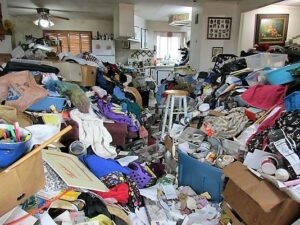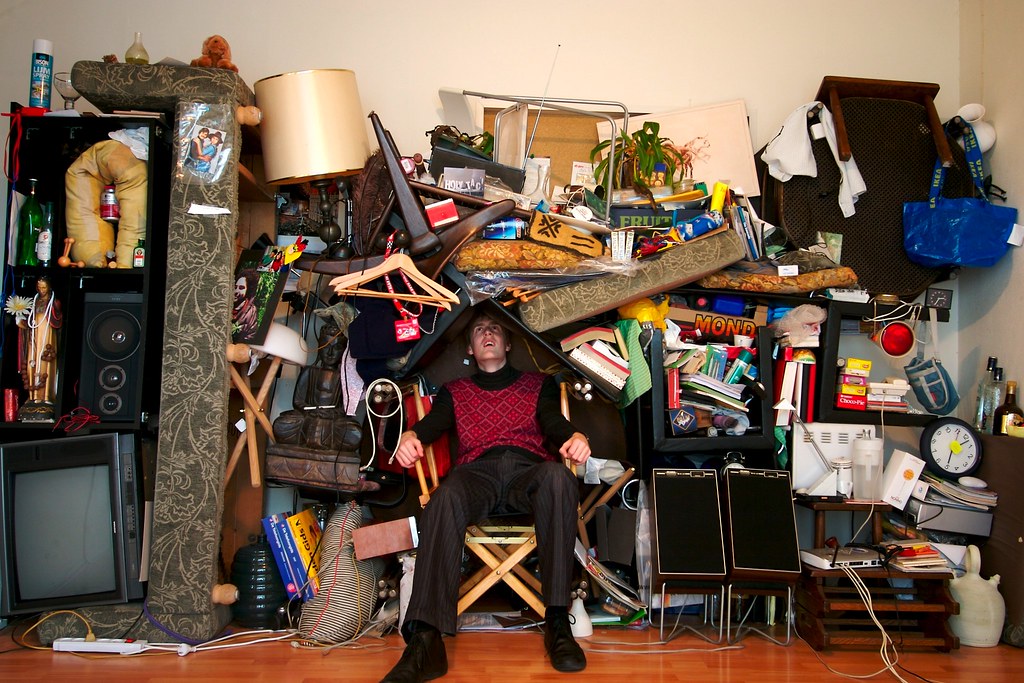Do you know someone who can’t stop collecting things? Maybe they have so many items that their home is cluttered and they can’t even use the rooms. This is called compulsive hoarding, and it’s a type of mental disorder. In this blog post, we will discuss compulsive hoarding in detail. We will cover what it is, the symptoms, how to treat it, and more!
Contents
- 1 What Is Compulsive Hoarding?
- 2 What Are The Causes?
- 2.1 Experience of traumatic events in past
- 2.2 Low self-esteem or feeling of insecurity
- 2.3 Perfectionism or thoughts of high standards
- 2.4 Struggle with mental health disorders
- 2.5 Difficulty making decisions
- 2.6 Lack of organizational skills
- 2.7 Being a compulsive shopper
- 2.8 A lot of free time on your hands
- 2.9 Residence where there is easy access to stuff
- 3 What Are The Consequences?
- 4 How Can Therapies Help?
- 5 How Can Medications Help?
- 6 How Can Self-Care Strategies help?
- 7 Conclusion
What Is Compulsive Hoarding?
 Compulsive hoarding is a mental disorder characterized by an obsessive need to collect and hold onto objects, even if they serve no purpose.
Compulsive hoarding is a mental disorder characterized by an obsessive need to collect and hold onto objects, even if they serve no purpose.
People who suffer from compulsive hoarding often feel a strong emotional attachment to their belongings and have difficulty getting rid of them, even if they are useless. The condition can severely impair a person’s ability to function in everyday life and can cause serious health and safety problems.
What Are The Symptoms?
You may see the following symptoms in someone who is suffering from compulsive hoarding:
- Difficulty throwing things away, even if they are useless
- Strong emotional attachment to belongings
- The compulsive need to acquire more items
- Cluttered living spaces that make it difficult to move around or use rooms for their intended purpose
- Health and safety problems caused by the hoard
- Social isolation
Keep an eye on your symptoms and see how minor or major they are.
What Are The Causes?
Below explained are some of the risk elements which cause compulsive hoarding.
Experience of traumatic events in past
Compulsive hoarding is not just about collecting things; it’s about the emotional attachment that people feel to their belongings. When someone experiences a loss or trauma, they may turn to their possessions for comfort.
For example, a child who witnesses a house fire may develop compulsive hoarding tendencies as a result of the trauma. Adults who have experienced traumatic events such as natural disasters or violence may also develop compulsive hoarding behaviors.
This can lead to compulsive hoarding behaviors as people try to hold on to as many things as possible in an attempt to stave off feelings of insecurity and anxiety. For example, someone who has experienced the death of a loved one may start hoarding items that belonged to that person.
Low self-esteem or feeling of insecurity
Compulsive hoarding is often a way of dealing with low self-esteem or insecurity. For example, a person who feels like they are not good enough may try to compensate by collecting as many things as possible. This gives them a false sense of security and makes them feel better about themselves.
For example, if someone has low self-esteem and feels like they are not good enough, they may try to compensate by collecting as many things as possible. This gives them a false sense of security and makes them feel better about themselves.
Perfectionism or thoughts of high standards
Compulsive hoarding can be brought on by several different factors. For some people, it may be the result of being a perfectionist or having high standards. If someone is constantly worried that their home isn’t clean enough or that they don’t have enough possessions to meet their standards, they may start to hoard items as a way to cope with these feelings of anxiety.
For example, a perfectionist may start to hoard cleaning supplies because they are worried that their home isn’t clean enough. Or, someone with high standards may start to hoard clothes because they feel like they don’t have enough to wear.
Struggle with mental health disorders
There are many different reasons why someone might start compulsive hoarding. For some people, it may be a way to deal with anxiety or depression. Other mental health disorders can also cause compulsive hoarding.
For example, people with OCD may start compulsive hoarding as a way to relieve their anxiety. They may believe that if they hoard certain objects, they will be able to prevent something bad from happening. This can lead to a spiral of compulsive hoarding, as the person tries to hoard more and more objects in an attempt to feel safe.
People with ADHD may also start compulsively hoarding as a way to cope with their disorder. The chaotic nature of ADHD can make it difficult for people to keep track of their belongings. This can lead to them feeling like they need to hoard objects to feel safe and secure.
Difficulty making decisions
Compulsive hoarding can be caused by many things, but one of the most common factors is difficulty making decisions. This can lead to a person feeling like they need to keep everything just in case it might be useful later on.
For example, someone may hold onto old clothes. They feel they may fit again someday or keep every single Christmas decoration because they might want to use them all in future years. The problem with this way of thinking is that it leads to cluttered and dangerous living conditions.
Lack of organizational skills
Compulsive hoarding is often caused by a lack of organizational skills. This can lead to an individual feeling overwhelmed by their possessions and not knowing where to start when it comes to decluttering.
For example, if someone has a collection of items that they are emotionally attached to, they may have trouble getting rid of anything because they can’t bear the thought of losing any of their belongings. Such a person may hoard plenty of items in a disorganized way as he/she lacks proper organization skills.
Being a compulsive shopper
A compulsive hoarder has an obsessive need to acquire and keep items, even if they are of no use or value. People with this condition may compulsively hoard anything, from clothes and books to food and trash.
For example, a compulsive hoarder may keep stacks of newspapers, even though they never read them, because they feel they might need them someday.
Another example is a compulsive hoarder who may buy dozens of pairs of shoes, even though they only wear a few.
A lot of free time on your hands
Compulsive hoarding can be caused by several things, but one of the most common triggers is having a lot of free time on your hands. This can be due to retirement, unemployment, or simply having too much leisure time.
When people are bored, they often turn to compulsive activities like shopping or gambling. For some people, compulsive hoarding provides a sense of purpose and satisfaction. They may feel that their possessions give them a sense of control over their lives. Others may hoard out of fear that they will need something in the future.
Residence where there is easy access to stuff
Compulsive hoarding often occurs in people who have easy access to stuff. For example, people who live in areas where there are garage sales or thrift stores may be more likely to hoard items. For example, if you have a garage, a store room, etc, in your house, you feel you have easy access to store your stuff. You may fill that space with your irrelevant stuff which results in compulsive hoarding.
What Are The Consequences?
Compulsive hoarding can have several consequences, both for the individual and for those around them. These can include:
Difficulty keeping up with everyday tasks 
Compulsive hoarding is a mental disorder that can result in difficulty keeping up with everyday tasks like cooking, cleaning, and laundry.
For example, you may not be able to do your daily tasks at home as the required equipment may be lost in that huge clutter you have stored. You are not able to find the necessary tools to perform your daily routine activities. This piles up your home tasks such as cooking, cleaning utensils and clothes, laundry, and so on.
Poor personal hygiene
Compulsive hoarding can result in poor personal hygiene. When a person has compulsive hoarding tendencies, they may not take care of their hygiene as well as they should. This can lead to poor grooming habits, an unkempt appearance, and eventually serious health problems.
In extreme cases, compulsive hoarders have been known to live in their filth, surrounded by garbage and rotting food. This is not only unsanitary and dangerous for the hoarder, but it can also pose a serious health risk to anyone else who enters the home.
Increased risk of injury
Compulsive hoarding often results in an increased risk of injury, as homes become cluttered and trip hazards abound. For example, a person with compulsive hoarding may have difficulty walking through their home due to the clutter, which can lead to trips and falls.
In addition, compulsive hoarders often store items in unsafe locations, such as on top of piles of clothes or in cabinets that are not easily accessible. This can make it difficult to find items when they are needed and can also result in items being dropped on people or pets.
All of these factors can contribute to an increased risk of injury for those with compulsive hoarding.
Isolation from friends and family
Compulsive hoarding often results in isolation from friends and family. This is because compulsive hoarders are ashamed of the state of their homes, and as a result, they cancel or miss social events. For example, a compulsive hoarder may be too embarrassed to have friends over for dinner because their home is cluttered and messy.
As a result, they may start to isolate themselves and withdraw from social activities. This can lead to further isolation and loneliness. Compulsive hoarding can also cause strain on relationships.
For example, a spouse or partner may become frustrated with the hoarder’s behavior and start to distance themselves. This can lead to arguments and conflict within the relationship. Ultimately, compulsive hoarding can hurt both the hoarder and their loved ones.
Financial difficulties
Compulsive hoarding can result in financial difficulties. For example, a person with compulsive hoarding may spend money on unnecessary items instead of bills or rent. This can lead to missed payments, late fees, and eviction notices. In extreme cases, compulsive hoarders may even lose their homes.
The situation gets so worsened that the compulsive hoarder may have to live in their car or on the streets. Financial difficulties are just one of the many ways that compulsive hoarding can negatively impact a person’s life.
Neglect and abuse of the animals involved
Compulsive hoarding often leads to Animal hoarding that can result in neglect and abuse of the animals involved. This is because hoarders may not be able to provide proper care for their animals, leading to overcrowding, unsanitary conditions, and lack of food and water.
In some cases, animals may even be injured or killed as a result of compulsive hoarding. To take an example, let’s assume that a person has a compulsive need to hoard cats. This person may start with just a few cats, but over time, the number of cats in their care can quickly spiral out of control.
Soon, they may have dozens or even hundreds of cats living in their home, and the conditions can become very unsanitary and dangerous for both the animals and the hoarders themselves. The animals may suffer from malnutrition, dehydration, disease, and injuries due to neglect and abuse.
Eviction or even homelessness
Compulsive hoarding can result in eviction or even homelessness. This is because compulsive hoarders often have so much stuff that they cannot keep their homes clean and tidy. This can lead to landlords evicting them, or even the local authorities taking away their homes. In extreme cases, compulsive hoarders may end up living on the streets.
Let’s take an example. An individual is a compulsive hoarder. He has so much stuff in his house that he can barely move around. His family has tried to help him clean up, but it’s just too much for them. Eventually, his landlord evicts him and he is forced to live on the streets. As you can see, compulsive hoarding can have devastating consequences.
These are just some of how compulsive hoarding can negatively impact someone’s life. Therefore, compulsive hoarding is a serious condition that can have a profound impact on the lives of those affected by it.
How Can Therapies Help?
There are a few different types of therapies that may help manage compulsive hoarding. These include:
Cognitive-Behavioral Therapy
 CBT helps people with compulsive hoarding to identify and challenge the distorted beliefs that contribute to their excessive hoarding behavior.
CBT helps people with compulsive hoarding to identify and challenge the distorted beliefs that contribute to their excessive hoarding behavior.
CBT also teaches people how to declutter their homes and manage their possessions in a more organized way. Some common distorted beliefs include: “I might need this someday,” “I can’t throw this away, it’s still useful,” and “If I get rid of this, something bad will happen.” Once these distorted beliefs are identified, the therapist works with the patient to challenge and change these beliefs.
CBT also teaches compulsive hoarders specific skills for decluttering their homes and managing their possessions in a more organized way. These skills include:
- learning how to let go of unneeded or unused items
- sorting through belongings and deciding what to keep, throw away, or donate
- creating a storage plan for the remaining items
- implementing regular decluttering sessions
Regular practice of these skills is essential for helping compulsive hoarders overcome their disorder. With the help of CBT, many people with compulsive hoarding can reduce the amount of clutter in their homes and live more organized lives.
Exposure And Response Prevention Therapy
ERP is effective in treating compulsive hoarding. It involves gradually exposing the person to situations that trigger hoarding urges (e.g., going through one’s belongings or visiting a cluttered home), while at the same time teaching them healthy coping strategies to deal with the urge to hoard (e.g., deep breathing, walking away from the trigger).
With ERP, you can be taught how to manage and overcome compulsive hoarding. The goal is to help you feel more in control of your possessions and less anxious about letting go of things. With the right treatment, many people with compulsive hoarding can live much happier and healthier lives.
Acceptance And Commitment Therapy
ACT helps compulsive hoarders by teaching them to accept their thoughts and feelings without judgment. This allows them to focus on what is important to them and let go of what is not. For example, compulsive hoarders may be able to let go of some of their possessions if they realize that holding onto those things is preventing them from living the life they want to live.
Compulsive hoarding can be a difficult disorder to overcome, but with the help of Acceptance and Commitment Therapy, it is possible to manage and eventually overcome the compulsive urge to hoard.
The therapist will help the patient to understand their thoughts and feelings about their possessions, and then work with them to let go of the things that are not important. With time and patience, compulsive hoarding can be overcome and a person can live a normal, happy life.
Dialectical Behavior Therapy
DBT is an effective treatment for compulsive hoarding. It teaches skills that help people manage their emotions and cope with stressful situations.
One of the key components of DBT is mindfulness. Mindfulness helps people to be aware of the present moment, without judgment. This allows them to accept their thoughts and feelings, without getting caught up in them.
Mindfulness also helps people to be aware of their surroundings and the people in them. This can help hoarders to see the clutter in their homes, and to understand how it is affecting their life and the lives of those around them.
DBT also teaches skills for managing emotions. Emotional regulation skills help people to cope with difficult emotions, such as anxiety, sadness, and anger. These skills can help hoarders to deal with the distress that comes from letting go of items they have been holding on to.
In addition to mindfulness and emotional regulation, DBT teaches skills for interpersonal effectiveness. These skills can help hoarders to communicate assertively, set boundaries, and solve problems in their relationships. Interpersonal skills can also help hoarders to ask for help when they need it.
How Can Medications Help? 
Many potential medications could be prescribed for compulsive hoarding disorder, but the most common ones are antidepressants. Selective serotonin reuptake inhibitors (SSRIs) are often used to treat compulsive hoarding, as they can help to balance out the levels of serotonin in the brain. Other types of antidepressant medication may also be prescribed, depending on the individual’s specific situation. Examples include tricyclic antidepressants, monoamine oxidase inhibitors (MAOIs), etc.
But, it’s important to note that consultation with a mental health professional is necessary to determine which medication may work best for each case. Compulsive hoarding is a complex disorder, and medications should always be prescribed under the guidance of a professional.
How Can Self-Care Strategies help? 
Self-care strategies can help compulsive hoarders in several ways. For example, compulsive hoarders often have difficulty keeping their homes clean and tidy. This can lead to feelings of shame and embarrassment, and can even cause health problems.
Some self-care strategies to help you overcome compulsive hoarding include:
- Making a regular cleaning schedule and following it as closely as possible. This will help to keep the home clean and tidy and reduce the risk of health problems.
- Decluttering regularly. This will help to reduce the amount of clutter in the home and make it easier to keep on top of the hoarding problem.
- Spending time in nature. compulsive hoarders often feel calmer and more relaxed when they are surrounded by nature. This can help to reduce stress levels and improve mental well-being.
- Giving to the needy. another self-care strategy that can help compulsive hoarders is to give items that they no longer need or want to charity. This can help to reduce the amount of clutter in the home, and also provides a sense of satisfaction and fulfillment.
- Joining a support group. compulsive hoarders often find it helpful to join a support group for people with similar problems. This can provide valuable social support and allow members to share tips and advice on how to overcome their condition.
All of these self-care strategies can be extremely helpful in managing and overcoming compulsive hoarding. However, it is important to remember that everyone is different and what works for one person may not work for another. It is therefore important to experiment with different self-care strategies to find what works best for you.
Conclusion
Compulsive hoarding is a serious mental illness that needs to be taken seriously. If you or someone you know suffers from compulsive hoarding, don’t hesitate to reach out for help. There are many resources available to those who need them, and with the right support, compulsive hoarders can overcome their disorder.
Get out of it as soon as possible and start living a normal life. It is not going to be easy but compulsive hoarders can overcome their disorder with the right support and treatment.
Professional Guidance is the first step to moving toward your healing journey. You can try reaching Therapy Mantra to seek expert help in the comfort of your own home. Our therapists will help you get a solution to manage and overcome your problem. You can book your online therapy and talk directly to your assigned mentor. You may also download our free OCD treatment app on Android or iOS.






